Popular categories
Looking for a yarn?

65% Wool, 35% Alpaca
from 2.60 € /50g
Order DROPS Kid-Silk from Mallia Kouvaria - pleko.gr.

|
DROPS Kid-Silk uni colour 75% Mohair, 25% Silk |
5.05 € /25g |
Order |
Clicking the ORDER button will redirect you to Mallia Kouvaria - pleko.gr. website
Order DROPS Needles & Hooks
Clicking the ORDER button will redirect you to Mallia Kouvaria - pleko.gr. website
The yarn cost is calculated from the pattern’s smallest size and the yarn’s cheapest product type. Looking for an even better price? You might find it on the DROPS Deals!
Winter Owl Cardigan
Knitted jacket in DROPS Flora and DROPS Kid-Silk. The piece is worked top down with double neck, raglan and relief-pattern. Sizes S - XXXL.
DROPS Design: Pattern fl-084
Yarn group A + A or C
-------------------------------------------------------
SIZES:
S - M - L - XL - XXL - XXXL
YARN:
DROPS FLORA from Garnstudio (belongs to yarn group A)
250-250-250-300-300-350 g colour 01, off white
And use:
DROPS KID-SILK from Garnstudio (belongs to yarn group A)
225-225-250-275-300-350 g colour 01, off white
BUTTONS:
DROPS BUTTONS NO 522: 6-6-7-7-8-8 items.
NEEDLES:
DROPS CIRCULAR NEEDLE SIZE 5.5 MM: Length 40 cm and 80 cm.
DROPS CIRCULAR NEEDLE SIZE 4.5 MM: Length 80 cm.
DROPS DOUBLE POINTED NEEDLES SIZE 5.5 MM.
DROPS DOUBLE POINTED NEEDLES SIZE 4.5 MM.
The technique MAGIC LOOP can be used – you then only need 80 cm circular needle in each size.
KNITTING TENSION:
16 stitches in width and 20 rows in height with stocking stitch and 1 strand DROPS Flora + 2 strands DROPS Kid-Silk = 10 x 10 cm.
NOTE: Needle size is only a guide. If you get too many stitches on 10 cm, change to a larger needle size. If you get too few stitches on 10 cm, change to a smaller needle size.
-------------------------------------------------------
Alternative Yarn – See how to change yarns here
Yarn Groups A to F – Use the same pattern and change the yarn here
Yarn usage using an alternative yarn – Use our yarn converter here
-------------------------------------------------------
Women Jackets & Cardigansassembly free double neck raglan relief round neck top down

65% Wool, 35% Alpaca
from 2.60 € /50g
Order DROPS Flora from Mallia Kouvaria - pleko.gr.

|
DROPS Kid-Silk uni colour 75% Mohair, 25% Silk 5.05 € /25g Order |
Clicking the ORDER button will redirect you to Mallia Kouvaria - pleko.gr. website
Order DROPS Needles & Hooks
Clicking the ORDER button will redirect you to Mallia Kouvaria - pleko.gr. website
The yarn cost is calculated from the pattern’s smallest size and the yarn’s cheapest product type. Looking for an even better price? You might find it on the DROPS Deals!
- English (UK/cm), Greece
- Česky
- Dansk
- Deutsch
- Eesti keel
- English (UK/cm)
- English (US/in)
- Español
- Français
- Íslenska
- Italiano
- Magyar
- Nederlands
- Norsk
- Polski
- Português
- Suomi
- Svenska
- English (UK/cm), Bulgaria
- English (UK/cm), Croatia
- English (UK/cm), Latvia
- English (UK/cm), Lithuania
- English (UK/cm), Romania
- English (UK/cm), Slovenia
- Česky, Slovakia
Pattern instructions
EXPLANATIONS FOR THE PATTERN:
-------------------------------------------------------
GARTER STITCH (worked back and forth):
Knit all rows.
1 ridge = knit 2 rows.
PATTERN:
See diagrams A.1 to A.7. Choose diagram for your size (applies to A.3 and A.6). The diagrams show all rows in the pattern from the right side.
DECREASE TIP (for sleeves):
Decrease 1 stitch on either side of the marker-thread as follows: Work until there are 3 stitches left before the marker-thread, slip 1 stitch knit-wise, knit 1 and pass the slipped stitch over the knitted stitch, knit 2 (marker-thread sits between these 2 stitches), knit 2 together (2 stitches decreased).
BUTTONHOLES:
Work buttonholes on the right band (when the garment is worn). Work from the right side when there are 3 stitches left on the row as follows: Make 1 yarn over, knit 2 together and knit 1. On the next row (wrong side), knit the yarn over to leave a hole.
The first buttonhole is worked on the first row on the yoke. Then work the other 5-5-6-6-7-7 buttonholes with approx. 10-10-9-9-8-8½ cm between each one.
-------------------------------------------------------
START THE PIECE HERE:
-------------------------------------------------------
JACKET – SHORT OVERVIEW OF THE PIECE.
The neck and yoke are worked back and forth with circular needle, from mid front and top down. The yoke is divided for body and sleeves and the body continued back and forth with circular needle. The sleeves are worked in the round with double pointed needles/short circular needle.
DOUBLE NECK:
Cast on 78-82-86-90-94-98 stitches with circular needle size 5.5 mm, 1 strand DROPS Flora and 2 strands DROPS Kid-Silk. Change to circular needle size 4.5 mm. Work rib (knit 2, purl 2) until there are 2 stitches left, knit 2. Work this rib back and forth for 5 cm.
On the next 2 rows cast on 6 stitches at the end of each row – the new stitches are worked in GARTER STITCH – read description above (bands) = 90-94-98-102-106-110 stitches.
Continue the rib with the bands in garter stitch until the neck measures 10 cm (neck edge will be folded down afterwards and will be 5 cm). Knit 1 row from the right side and increase 23 stitches (do not increase the bands) = = 113-117-121-125-129-133 stitches. Knit 1 row from the wrong side. Insert 1 marker after the band; the yoke is measured from here.
YOKE:
Change to circular needle size 5.5 mm and work from the right side as follows:
6 band stitches in garter stitch, A.1, A.2 (5-5-5-5-5-10 stitches), A.3 (left front piece).
Work A.4, A.5 and A.4 (left sleeve), A.6, A.7 (11-11-11-11-11-21 stitches) and A.3 (back piece), A.4, A.5 and A.4 (right sleeve), A.6, A.7 (5-5-5-5-5-10 stitches), A.1 and 6 band stitches in garter stitch (right front piece) – on this row start to work the BUTTONHOLES – read description above.
Continue the pattern and increase as shown in A.3, A.5 and A.6 (increase towards each A.4, and a total of 8 stitches increased on each row from the right side). The increased stitches are worked twisted into the pattern – no holes. The bands are worked in garter stitch throughout. REMEMBER THE KNITTING TENSION!
Diagram A.1, A.2, A.4 and A.7 are repeated in height. When diagrams A.3, A.5 and A.6 are finished in height, continue to increase as before until you have increased a total of 17-19-23-25-27-30 times (including the increases in A.3, A.5 and A.6) = 249-269-305-325-345-373 stitches. Then continue with garter stitch and stocking stitch until the yoke measures 20-22-23-25-27-30 cm from the marker.
Now divide for the body and sleeves from the right side as follows:
6 band stitches in garter stitch, 37-39-44-48-51-57 stitches in stocking stitch (left front piece), place the next 43-49-57-59-63-65 stitches on a thread (sleeve) cast on 8-10-10-10-10-8 stitches under the sleeve, work 76-80-90-98-104-116 stitches in stocking stitch (back piece), place the next 43-49-57-59-63-65 stitches on a thread (sleeve) cast on 8-10-10-10-10-8 stitches under the sleeve, work 38-40-45-49-52-58 stitches in stocking stitch and 6 band stitches in garter stitch. The body and sleeves are finished separately.
BODY:
= 179-191-211-227-239-259 stitches.
Continue with stocking stitch and 6 band stitches in garter stitch on each side until the body measures 33-33-34-34-34-33 cm from the division. Knit 1 row from the right side and increase 23-27-27-31-31-35 stitches evenly spaced (do not increase over the bands) = 202-218-238-258-270-294 stitches. Work back from the wrong side, then work rib as follows from the right side:
6 band stitches in garter stitch, * knit 2, purl 2 *, work from *-* until there are 8 stitches left, knit 2 and 6 band stitches in garter stitch. Continue this rib for 6 cm. Cast off with knit over knit and purl over purl.
The piece measures approx. 63-65-67-69-71-73 cm from the neck.
SLEEVES:
Place the 43-49-57-59-63-65 stitches from the thread on the one side of the piece on short circular needle/double pointed needles size 5.5 mm and knit up 1 stitch in each of the 8-10-10-10-10-8 stitches cast on under the sleeve = 51-59-67-69-73-73 stitches. Insert a marker-thread in the middle of the new stitches under the sleeve.
Continue stocking stitch in the round.
When the sleeve measures 3 cm, decrease 1 stitch on each side of the marker-thread – read DECREASE TIP. Decrease like this every 6-4-2½-2-1½-1½ cm a total of 5-7-11-11-13-12 times = 41-45-45-47-47-49 stitches. When the sleeve measures 33-31-31-29-28-25 cm, knit 1 round and increase 7-7-7-9-9-11 stitches evenly spaced = 48-52-52-56-56-60 stitches. Change to double pointed needles size 4.5 mm and work rib (knit 2, purl 2) for 6 cm. Cast off with knit over knit and purl over purl. The sleeve measures approx. 39-37-37-35-34-31 cm from the division.
Work the other sleeve in the same way.
ASSEMBLY:
Sew the buttons onto the left band. Fold the neck double to the inside and sew down. To avoid the neck being tight and rolling outwards, it is important that the seam is elastic. Sew the openings on the bands with small stitches.
This pattern has been corrected. Click here to see the correction/s.
Correction yarn amount and information about tension.
The diagrams has been updated. Correction under yoke in all sizes.
Correction on yoke and division for sleeve and body.
Diagram

|
= knit from right side, purl from wrong side |

|
= purl from right side, knit from wrong side |

|
= between 2 stitches make 1 yarn over, which is worked twisted on the next row – no hole. |

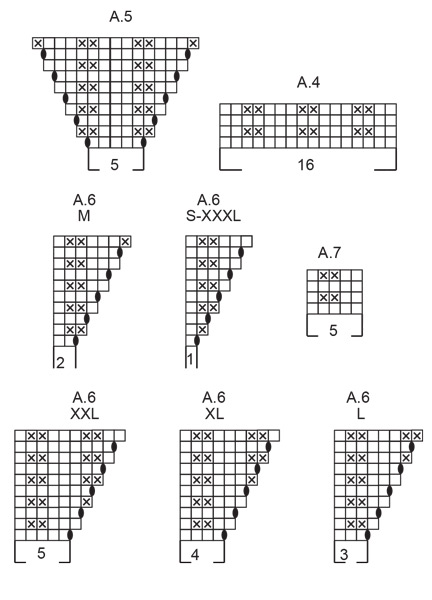
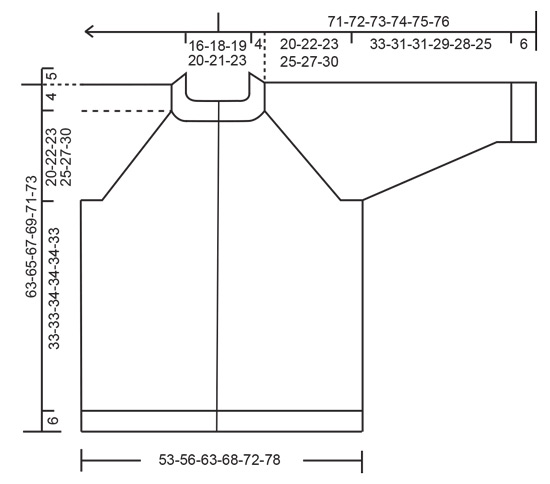
What can you do with our patterns? You can share DROPS patterns online, using the pattern original picture, materials, name and number. But you are NOT ALLOWED to reproduce the complete pattern digitally in any way. Yarn stores are welcome to use the DROPS pattern database to promote the sale of our assortment. You can print out our patterns, make as many copies as you’d like. The only thing we ask is that you don't make any changes / additions to the original printed document. And that the patterns according to the DROPS philosophy are given out to the consumers for free. Editorials that wish to publish our patterns in printed books or magazines can contact us for more information. The sale of garments based on DROPS patterns is permitted as long as they are sold as single items or per order. Further commercial use of the patterns is not permitted. It has to be clearly stated that the garment is made based on a design from DROPS DESIGN. The use of clothing labels of which DROPS DESIGN forms part is conditioned by the inclusion of the following text: “A DROPS DESIGN made by …..”. The use of DROPS photos for marketing purposes/sales is only permitted in connection with the use/sale of DROPS products. The photos may not be cut or edited and the logo should be clearly visible.
We reserve the right to withdraw the permission for use of our patterns at any time, notwithstanding the reason.
Each of our patterns has specific tutorial videos to help you.
These step-by-step tutorials might also help you:
Why is the knitting/crochet tension so important?
Knitting tension is what determines the final measurements of your work, and is usually measured per 10 x 10 cm. It is provided like so: number of stitches in width x number of rows in height - eg: 19 stitches x 26 rows = 10 x 10 cm.
The knitting tension is very individual; some people knit/crochet loosely while others work tightly. You adjust the knitting tension with the needle size, which is why the suggested needle size is only meant as a guide! You need to adjust this (up or down) to ensure that YOUR knitting tension matches the knitting tension provided in the pattern. If you work with a different knitting tension than provided you will have a different yarn consumption, and your work will have different measurements than what the pattern suggests.
The knitting tension also determines which yarns can replace each other. As long as you achieve the same knitting tension you can replace one yarn with another.
See DROPS lesson: How to measure your tension/gauge
See DROPS video: How to make a gauge tension swatch
How do I know how many balls of yarn I need?
The required amount of yarn is provided in grams, eg: 450 g. To calculate how many balls you’ll need you first need to know how many grams are in 1 ball (25g, 50g or 100g). This information is available if you click on the individual yarn quality on our pages. Divide the amount required with the amount of each ball. For example, if each ball is 50g (the most common amount), the calculation will be as follows: 450 / 50 = 9 balls.
Can I use a different yarn than what the pattern suggests?
The important thing when changing from one yarn to another is that the knitting/crochet tension remains the same. This is so that the measurements of the finished piece will be the same as on the sketch provided. It is easier to achieve the same knitting tension using yarns from the same yarn group. It is also possible to work with multiple strands of a thinner yarn to achieve the knitting tension of a thicker one. Please try our yarn converter. We recommend you to always work a test swatch.
Please NOTE: when changing yarn the garment might have a different look and feel to the garment in the photo, due to individual properties and qualities of each yarn.
See DROPS lesson: Can I use a different yarn than the one mentioned in the pattern?
What are the yarn groups?
All our yarns are categorised into yarn groups (from A to F) according to thickness and knitting tension – group A contains the thinnest yarns and group F the thickest. This makes it easier for you to find alternative yarns to our patterns, should you wish to switch yarn. All yarns within the same group have a similar knitting tension and can easily replace each other. However, different yarn qualities have different structures and properties which will give the finished work a unique look and feel.
How do I use the yarn calculator?
At the top of all our patterns you’ll find a link to our yarn calculator, which is a helpful tool should you wish to use a different yarn than suggested. By filling in the yarn quality you wish to replace, the amount (in your size) and number of strands, the calculator will present good alternative yarns with the same knitting tension. Additionally it will tell you how much you’ll require in the new qualities and whether you’ll need to work with multiple strands. Most skeins are 50g (some are 25g or 100g).
If the pattern is worked with multiple colours, every colour will have to be calculated separately. Similarly, if the pattern is worked with several strands of different yarns (for example 1 strand Alpaca and 1 strand Kid-Silk) you will have to find alternatives for each, individually.
Why do you show discontinued yarns in the patterns?
Since different yarns have different qualities and textures we have chosen to keep the original yarn in our patterns. However, you can easily find options among our available qualities by using our yarn calculator, or simply pick a yarn from the same yarn group.
It is possible that some retailers still have discontinued yarns in stock, or that someone has a few skeins at home that they would like to find patterns for.
The yarn calculator will provide both alternative yarn as well as required amount in the new quality.
What size should I knit?
If you think it's hard to decide what size to make, it can be a good idea to measure a garment you own already and like the size of. Then you can pick the size by comparing those measures with the ones available in the pattern's size chart.
You'll find the size chart at the bottom of the pattern.
See DROPS lesson: How to read size chart
Why do I get the wrong knitting tension with the suggested needle size?
The needle size provided in the pattern serves only as a guide, the important thing is to follow the knitting tension. And since knitting tension is very individual, you will have to adjust the needle size to ensure that YOUR tension is the same as in the pattern – maybe you’ll have to adjust 1, or even 2 needle sizes, up or down to achieve the correct tension. For this, we recommend that you work test swatches.
Should you work with a different knitting tension than the one provided, the measurements of the finished garment might deviate from the measurement sketch.
See DROPS lesson: How to measure your tension/gauge
See DROPS video: How to make a tension/gauge swatch
Why is the pattern worked top-down?
Working a garment top-down provides more flexibility and room for personal adjustment. For example it is easier to try the garment on while working, as well as making adjustments to length of yoke and shoulder caps.
The instructions are carefully explaining every step, in the correct order. Diagrams are adjusted to the knitting direction and are worked as usual.
How do I work according to a knitting diagram?
The diagram depicts all rows/rounds, and every stitch seen from the right side. It is read from bottom to top, from right to left. 1 square = 1 stitch.
When working back and forth, every other row is worked from the right side and every other row is worked from the wrong side. When working from the wrong side, the diagram will have to be worked reversed: from left to right, knit stitches are purled, purl stitches are knit etc.
When working in the round every round is worked from the right side and the diagram are worked from right to left on all rounds.
See DROPS lesson: How to read knitting diagrams
How do I work according to a crochet diagram?
The diagram depicts all rows/rounds, and every stitch seen from the right side. It is worked from bottom to top, from right to left.
When working back and forth every other row is worked from the right side: from right to left and every other row is worked from the wrong side: from left to right.
When working in the round, every row in the diagram are worked from the right side, from right to left.
When working a circular diagram you start in the middle and work your way outwards, counter clockwise, row by row.
The rows usually start with a given number of chain stitches (equivalent to the height of the following stitch), this will either be depicted in the diagram or explained in the pattern.
See DROPS lesson: How to read crochet diagrams
How do I work several diagrams simultaneously on the same row/round?
Instructions for working several diagrams after each other on the same row/round, will often be written like so: “work A.1, A.2, A.3 a total of 0-0-2-3-4 times". This means you work A.1 once, then A.2 is worked once, and A.3 is repeated (in width) the number of times provided for your size – in this case like so: S = 0 times, M = 0 times, L=2 times, XL= 3 times and XXL = 4 times.
The diagrams are worked as usual: begin with the first row in A.1, then work the first row in A.2 etc.
See DROPS lesson: How to read knitting diagrams
See DROPS lesson: How to read crochet diagrams
Why are the sleeves shorter in larger sizes?
The total width of the garment (from wrist-to-wrist) will be larger in the larger sizes, despite the actual sleeves being shorter. The larger sizes have longer sleeve caps and wider shoulders, so there will be a good fit in all sizes.
Where on the garment is the length measured?
The measurement sketch/schematic drawing provides information regarding the full length of the garment. If it’s a jumper or a jacket the length is measured from the highest point on the shoulder closest to the neckline, and straight down to the bottom of the garment. It is NOT measured from the tip of shoulder. Similarly, the length of yoke is measured from the highest point on the shoulder and down to where yoke is split into body and sleeves.
On a jacket measures are never taken along bands, unless specifically stated. Always measure inside band stitches when measuring the length.
See DROPS lesson: How to read a schematic drawing
What is a repeat?
Diagrams are often repeated on the round or in height. 1 repeat is the diagram the way it appears in the pattern. If it says to work 5 repeats of A.1 in the round, then you work A.1 a total of 5 times after/next to each other in the round. If it says to work 2 repeats of A.1 vertically/in height you work the entire diagram once, then begin again at the start and work the entire diagram one more time.
Why does the piece start with more chain stitches than it’s worked with?
Chain stitches are slightly narrower than other stitches and to avoid working the cast-on edge too tight, we simply chain more stitches to begin with. The stitch count will be adjusted on the following row to fit the pattern and measurement sketch.
Why increase before the rib edge when the piece is worked top-down?
The rib edge is more elastic and will contract slightly compared to, for example, stocking stitch. By increasing before the rib edge, you avoid a visible difference in width between the rib edge and the rest of the body.
Why increase in the cast-off edge?
It’s very easy to cast off too tightly, and by making yarn overs while casting off (and simultaneously casting these off) you avoid a too tight cast off edge.
See DROPS video: How to bind off with yarn overs (yo)
How do I increase/decrease on every 3rd and 4th row/round alternately?
To achieve an even increase (or decrease) you can increase on, for example: every 3rd and 4th row alternately, like so: work 2 rows and increase on the 3rd row, work 3 rows and increase on the 4th. Repeat this until the increase is complete.
See DROPS lesson: Increase or decrease 1 st on every 3rd and 4th row alternately
How can I work a jacket in the round instead of back and forth?
Should you prefer to work in the round instead of back and forth, you may of course adjust the pattern. You’ll need to add steeks mid-front (usually 5 stitches), and follow the instructions. When you would normally turn and work from the wrong side, simply work across the steek and continue in the round. At the end you’ll cut the piece open, pick up stitches to work bands, and cover the cut edges.
See DROPS video: How to knit steeks and cut open
Can I work a jumper back and forth instead of in the round?
Should you prefer to work back and forth instead of in the round, you may of course adjust the pattern so you work the pieces separately and then assemble them at the end. Divide the stitches for the body in 2, add 1 edge stitch in each side (for sewing) and work the front and back pieces separately.
See DROPS lesson: Can I adapt a pattern for circular needles into straight needles?
Why is the pattern slightly different than what I see in the photo?
Pattern repeats can vary slightly in the different sizes, in order to get the correct proportions. If you’re not working the exact same size as the garment in the photo, yours might deviate slightly. This has been carefully developed and adjusted so that the complete impression of the garment is the same in all sizes.
Make sure to follow instructions and diagrams for your size!
How do I make a women’s size garment into a men’s size one?
If you have found a pattern you like which is available in women’s size it’s not very difficult to convert it to men’s size. The biggest difference will be the length of sleeves and body. Start working on the women size that you think would fit across the chest. The additional length will be worked right before you cast off for the armhole/sleeve cap. If the pattern is worked top-down you can add the length right after the armhole or before the first decrease on sleeve.
Regarding additional yarn amount, this will depend on how much length you add, but it is better with a skein too many than too few.
How do I prevent a hairy garment from shedding?
All yarns will have excess fibres (from production) that might come off as lint or shedding. Brushed yarns (ie hairier yarns) have more of these loose, excess fibres, causing more shedding.
Shedding also depends on what is worn under or over the garment, and whether this pulls at the yarn fibres. It’s therefore not possible to guarantee that there will be no shedding
Below are some tips on how to get the best result when working with hairier yarns:
1. When the garment is finished (before you wash it) shake it vigorously so the looser hairs come off. NOTE: do NOT use a lint roller, brush or any method that pulls at the yarn.
2. Place the garment in a plastic bag and put it in your freezer - the temperature will cause the fibres to become less attached to each other, and excess fibres will come off easier.
3. Leave in the freezer for a few hours before taking it out and shaking it again.
4. Wash the garment according to the instructions on the yarn label.
Why does my garment pill?
Pilling is a natural process that happens to even the most exclusive of fibers. It's a natural sign of wear and tear that is hard to avoid, and that is most visible in high friction areas of your garment like a sweater's arms and cuffs.
You can make your garment look as new by removing the pilling, using a fabric comb or a pill/lint remover.
In the meantime, you can read the questions and answers that others have left to this pattern or join the DROPS Workshop on Facebook to get help from fellow knitters/crocheters!
You might also like...
Winter Owl Cardigan |
||||||||||
 |
 |
|||||||||
Knitted jacket in DROPS Flora and DROPS Kid-Silk. The piece is worked top down with double neck, raglan and relief-pattern. Sizes S - XXXL.
DROPS 243-2 |
||||||||||
|
------------------------------------------------------- EXPLANATIONS FOR THE PATTERN: ------------------------------------------------------- GARTER STITCH (worked back and forth): Knit all rows. 1 ridge = knit 2 rows. PATTERN: See diagrams A.1 to A.7. Choose diagram for your size (applies to A.3 and A.6). The diagrams show all rows in the pattern from the right side. DECREASE TIP (for sleeves): Decrease 1 stitch on either side of the marker-thread as follows: Work until there are 3 stitches left before the marker-thread, slip 1 stitch knit-wise, knit 1 and pass the slipped stitch over the knitted stitch, knit 2 (marker-thread sits between these 2 stitches), knit 2 together (2 stitches decreased). BUTTONHOLES: Work buttonholes on the right band (when the garment is worn). Work from the right side when there are 3 stitches left on the row as follows: Make 1 yarn over, knit 2 together and knit 1. On the next row (wrong side), knit the yarn over to leave a hole. The first buttonhole is worked on the first row on the yoke. Then work the other 5-5-6-6-7-7 buttonholes with approx. 10-10-9-9-8-8½ cm between each one. ------------------------------------------------------- START THE PIECE HERE: ------------------------------------------------------- JACKET – SHORT OVERVIEW OF THE PIECE. The neck and yoke are worked back and forth with circular needle, from mid front and top down. The yoke is divided for body and sleeves and the body continued back and forth with circular needle. The sleeves are worked in the round with double pointed needles/short circular needle. DOUBLE NECK: Cast on 78-82-86-90-94-98 stitches with circular needle size 5.5 mm, 1 strand DROPS Flora and 2 strands DROPS Kid-Silk. Change to circular needle size 4.5 mm. Work rib (knit 2, purl 2) until there are 2 stitches left, knit 2. Work this rib back and forth for 5 cm. On the next 2 rows cast on 6 stitches at the end of each row – the new stitches are worked in GARTER STITCH – read description above (bands) = 90-94-98-102-106-110 stitches. Continue the rib with the bands in garter stitch until the neck measures 10 cm (neck edge will be folded down afterwards and will be 5 cm). Knit 1 row from the right side and increase 23 stitches (do not increase the bands) = = 113-117-121-125-129-133 stitches. Knit 1 row from the wrong side. Insert 1 marker after the band; the yoke is measured from here. YOKE: Change to circular needle size 5.5 mm and work from the right side as follows: 6 band stitches in garter stitch, A.1, A.2 (5-5-5-5-5-10 stitches), A.3 (left front piece). Work A.4, A.5 and A.4 (left sleeve), A.6, A.7 (11-11-11-11-11-21 stitches) and A.3 (back piece), A.4, A.5 and A.4 (right sleeve), A.6, A.7 (5-5-5-5-5-10 stitches), A.1 and 6 band stitches in garter stitch (right front piece) – on this row start to work the BUTTONHOLES – read description above. Continue the pattern and increase as shown in A.3, A.5 and A.6 (increase towards each A.4, and a total of 8 stitches increased on each row from the right side). The increased stitches are worked twisted into the pattern – no holes. The bands are worked in garter stitch throughout. REMEMBER THE KNITTING TENSION! Diagram A.1, A.2, A.4 and A.7 are repeated in height. When diagrams A.3, A.5 and A.6 are finished in height, continue to increase as before until you have increased a total of 17-19-23-25-27-30 times (including the increases in A.3, A.5 and A.6) = 249-269-305-325-345-373 stitches. Then continue with garter stitch and stocking stitch until the yoke measures 20-22-23-25-27-30 cm from the marker. Now divide for the body and sleeves from the right side as follows: 6 band stitches in garter stitch, 37-39-44-48-51-57 stitches in stocking stitch (left front piece), place the next 43-49-57-59-63-65 stitches on a thread (sleeve) cast on 8-10-10-10-10-8 stitches under the sleeve, work 76-80-90-98-104-116 stitches in stocking stitch (back piece), place the next 43-49-57-59-63-65 stitches on a thread (sleeve) cast on 8-10-10-10-10-8 stitches under the sleeve, work 38-40-45-49-52-58 stitches in stocking stitch and 6 band stitches in garter stitch. The body and sleeves are finished separately. BODY: = 179-191-211-227-239-259 stitches. Continue with stocking stitch and 6 band stitches in garter stitch on each side until the body measures 33-33-34-34-34-33 cm from the division. Knit 1 row from the right side and increase 23-27-27-31-31-35 stitches evenly spaced (do not increase over the bands) = 202-218-238-258-270-294 stitches. Work back from the wrong side, then work rib as follows from the right side: 6 band stitches in garter stitch, * knit 2, purl 2 *, work from *-* until there are 8 stitches left, knit 2 and 6 band stitches in garter stitch. Continue this rib for 6 cm. Cast off with knit over knit and purl over purl. The piece measures approx. 63-65-67-69-71-73 cm from the neck. SLEEVES: Place the 43-49-57-59-63-65 stitches from the thread on the one side of the piece on short circular needle/double pointed needles size 5.5 mm and knit up 1 stitch in each of the 8-10-10-10-10-8 stitches cast on under the sleeve = 51-59-67-69-73-73 stitches. Insert a marker-thread in the middle of the new stitches under the sleeve. Continue stocking stitch in the round. When the sleeve measures 3 cm, decrease 1 stitch on each side of the marker-thread – read DECREASE TIP. Decrease like this every 6-4-2½-2-1½-1½ cm a total of 5-7-11-11-13-12 times = 41-45-45-47-47-49 stitches. When the sleeve measures 33-31-31-29-28-25 cm, knit 1 round and increase 7-7-7-9-9-11 stitches evenly spaced = 48-52-52-56-56-60 stitches. Change to double pointed needles size 4.5 mm and work rib (knit 2, purl 2) for 6 cm. Cast off with knit over knit and purl over purl. The sleeve measures approx. 39-37-37-35-34-31 cm from the division. Work the other sleeve in the same way. ASSEMBLY: Sew the buttons onto the left band. Fold the neck double to the inside and sew down. To avoid the neck being tight and rolling outwards, it is important that the seam is elastic. Sew the openings on the bands with small stitches. |
||||||||||
Diagram explanations |
||||||||||
|
||||||||||

|
||||||||||

|
||||||||||

|
||||||||||
|
Have you made this or any other of our designs? Tag your pictures in social media with #dropsdesign so we can see them! Do you need help with this pattern?You'll find tutorial videos, a Comments/Questions area and more by visiting the pattern on garnstudio.com. © 1982-2024 DROPS Design A/S. We reserve all rights. This document, including all its sub-sections, has copyrights. Read more about what you can do with our patterns at the bottom of each pattern on our site. |
||||||||||
With over 40 years in knitting and crochet design, DROPS Design offers one of the most extensive collections of free patterns on the internet - translated to 17 languages. As of today we count 304 catalogues and 11422 patterns - 11422 of which are translated into English (UK/cm).
We work hard to bring you the best knitting and crochet have to offer, inspiration and advice as well as great quality yarns at incredible prices! Would you like to use our patterns for other than personal use? You can read what you are allowed to do in the Copyright text at the bottom of all our patterns. Happy crafting!








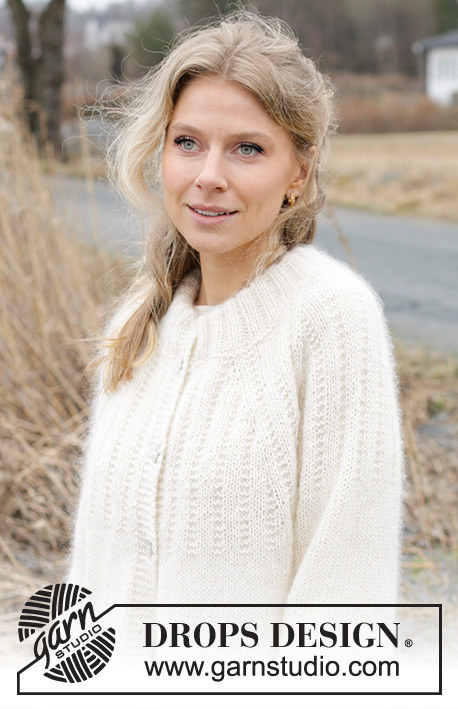
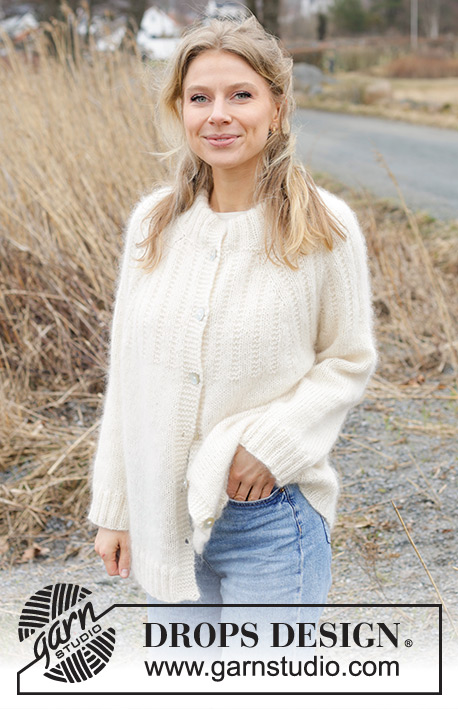


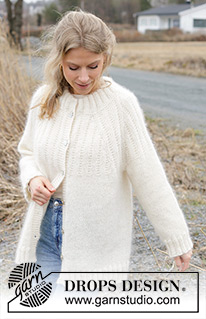
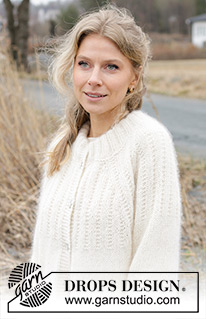
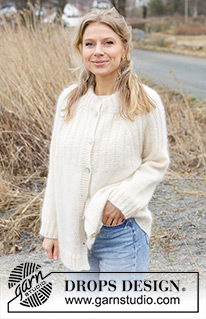

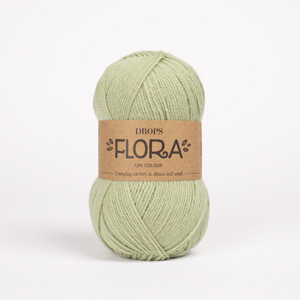
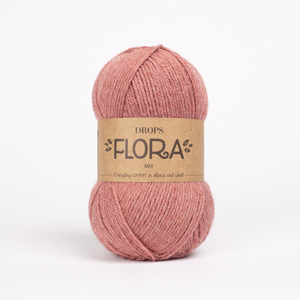









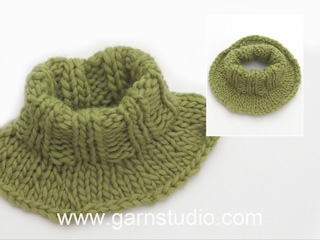








































Comments / Questions (25)
Pour ce modèle il est indiqué au début, pour l'empiècement, de tricoter A1, A2 (5-5-5-5-5-10 mailles), A3 Quelle est la signification des mailles entre parenthèses ? Sont-elles tricotées en plus (en fonction de la taille) entre les diagrammes A2 et A3 ? Merci d'avance pour votre réponse.
07.12.2023 - 17:10DROPS Design answered:
Bonjour Mme Thery, c'est effectivement le nombre de mailles pour chaque taille, autrement dit: en taille XXXL on tricotera ici 10 mailles de A.2, et seulement 5 dans les autres tailles. Bon tricot!
08.12.2023 - 08:18I would like to find a raglan sweater or cardigan that is knit in flat pieces. I do not want to knit in the round. Can you tell me what to enter in the search field to find patterns knit in flat pieces and then seamed? Thank you so much.
19.11.2023 - 14:22DROPS Design answered:
Dear Ramona, this pattern is worked back and forth on circular needle to get enough room for all stitches, this means you can use here straight needles for yoke (adjust the sleeves thanks to this lesson). You can find more using our search engine, but we have no tags still for this kind of projects as you can adjust to your own way to work. Happy knitting!
20.11.2023 - 10:44Bonjour, je viens de finir les diagrammes A3,A5 et A6, en taille L je suis donc a 163 m. Le patron dit de continuer à augmenter comme avant 23 fois au total (y compris augmentation de A3, A6 et A5) pour arriver à 307 m ! Je ne comprends pas comment augmenter ? Merci d’avance Cordialement Andrea
17.11.2023 - 12:21DROPS Design answered:
Bonjour Mme Le Tertre, augmentez simplement tout comme vous l'avez fait auparavant: avant et après chaque A.4 pour augmenter 8 mailles tous les rangs sur l'endroit (tous les 2 rangs); vous aviez 123 mailles avant de commencer les diagrammes + 8 mailles augmentées pour le raglan x 23 fois = 307 mailles. Bon tricot!
17.11.2023 - 14:57Jeg kan ikke få maskerne til at passe i første p efter hals strikke xxxl
02.11.2023 - 13:03DROPS Design answered:
Hei Charlotte. Hva er det som ikke stemmer? Bruk maskemarkører mellom hvert diagram, da har du en bedre oversikt. I str. XXXL skal det være 135 masker etter halskanten. Venstre forstykket: 6 stolpemasker + A.1 (1 maske) + A.2 (over 10 masker) + A.3 (1 maske) = 18 masker + 1 kast. Venstre erme: A.4 (16 masker), A.5 (5 masker) og A.4 (16 masker) = 37 masker + 2 kast. Bakstykket: A.6 (2 masker) + A.7 (over 21 masker) + A.3 (1 maske) = 24 masker + 2 kast. Høyre erme: A.4 (16 masker), A.5 (5 masker) og A.4 (16 masker) = 37 masker + 2 kast. Høyre forstykke: A.6 (2 masker) + A.7 (10 masker) + A.1 (1 maske) + 6 stolpemasker = 135 masker. mvh DROPS Design
06.11.2023 - 13:24Liebes Drops Tem, Ich stricke anscheinend eher eng und aus diesem Grund muss ich immer grössere Nadeln nehmen. Nun habe ich beim Strickmuster für dieses Model Nadelgrösse 8 anstatg 5.5 nehmen müssen um bei der Maschenprobe auf 10cm Breite zu kommen. Heisst das nun, dass ich dadurch auch mehr Wolle bestellen muss? Liebe Grüsse Anita
29.10.2023 - 12:31DROPS Design answered:
Liebe Anita, beachten Sie, daß Sie richtig mit 4 Fäden (2 Fäden Kid-Silk + 1 Faden Flora) stricken - sollte Ihre Maschenprobe dann in der Breite sowie in der Höhe richtig sein, dann brauchen Sie nicht mehr Wolle - hier lesen Sie mehr. Viel Spaß beim stricken!
30.10.2023 - 16:26Garn für mehr als 100 Euro bestellt, da ich diese Jacke für mich und eine mir sehr wichtige Person stricken möchte! Ab Reihe 10 des Mustersatzes ist es leider nicht mehr logisch für mich. Die Probleme beginnen schon mit den 11 Maschen für A7: Was genau soll ich da stricken? Ich nehme an, dass es l-r-r-l-l-l-r-r-l-l-l ist. Aber ich komme ab Reihe 11 insgesamt nicht mehr weiter! Warum so kompliziert? Ich bin eine erfahrene Strickerin, aber mit dieser Anleitung komme ich nicht zurecht! Danke
20.10.2023 - 19:54DROPS Design answered:
Liebe Tanja, wenn man A.7 über 11 Maschen stricken soll, wird es so gestrickt: wiederholen Sie die 5 Maschen A.7 2 Mal (= 10 Maschen) dann stricken Sie die 1. Masche A.7 (= 11 Maschen), so wird das Muster symmetrisch. Für die andere Diagramme sollen Sie die Zunahmen im Muster wie zuvor stricken, dh abwechslungsweise 4 Maschen glatt rechts, 2 Maschen Krausrechts (mit 2 M glatt rechts anfangen und 2 M glatt rechts enden wird das Muster symmetrisch). Viel Spaß beim stricken!
23.10.2023 - 10:30Leider verstehe ich in der Anleitung die Aufteilung der Passe überhaupt nicht.
10.10.2023 - 23:14DROPS Design answered:
Liebe Claudia, in dieser Lektion zeigen wir, wie man einen Pullover von oben nach unten strickt; ab 9. Bild zeigen wir, wie die Maschen für die Ärmel stillgelegt werden und wie die neuen Maschen unter die Ärmel angeschlagen werden - folgen Sie die Maschenanzahl für Ihre Größe (nicht wie bei der Lektion). Viel Spaß beim stricken!
11.10.2023 - 08:35Jatkona edelliseen kysymykseeni. Miten koon XXL 131s täsmää annettuihin kuvioihin ensimmäisellä kuviokerroksella? Ohje on sekava vaikka tähän on monta päivää käyttänyt, että ymmärtäisi ja pääsisi alkuun :(
16.09.2023 - 20:06Ensimmäisellä kuviokerroksella koossa XXL pitäisi olla 16s mutta ohjeen mukaan saan vain 11s. A6+A7+A3=11s :( Miten ratkaisen ongelman?
12.09.2023 - 18:00Pour XL : nbr de m au premier rang de l'empiècement selon diagramme= 109 m +12 m de bordures (123m au total) pour XL 127 m après aug des 25 m après col. que faire des 4 mailles de trop ? Merci de me répondre car je me calcule recalcule....et je veux faire ce beau gilet
08.09.2023 - 21:03DROPS Design answered:
Bonjour Mme Gliozzi, en taille L, vous aurez bien 123 mailles. mais en taille XL vous devez avoir 127mailles que vous allez tricoter ainsi: 6 m point mousse, A.1 (=1 m), A.2(= 5m ), A.3 (=4 m) pour le devant gauche, puis A.4 (16 m), A.5 (5 m), A.4 (16 m) pour la manche, puis: A.6 (5 m), A.7 (11 m) et A.3 (4 m) pour le dos, A.4 (16 m), A.5 (5 m), A.4 (16 m) pour l'autre manche et A.6 (5 m), A.7 (5 m), A.1 (1 m) et 6 m point mousse soit pour le devant droit, soit: 6+1+5+4+16+5+16+5+11+4+16+5+16+5+5+1+6= 127 mailles. Bon tricot!
11.09.2023 - 08:27